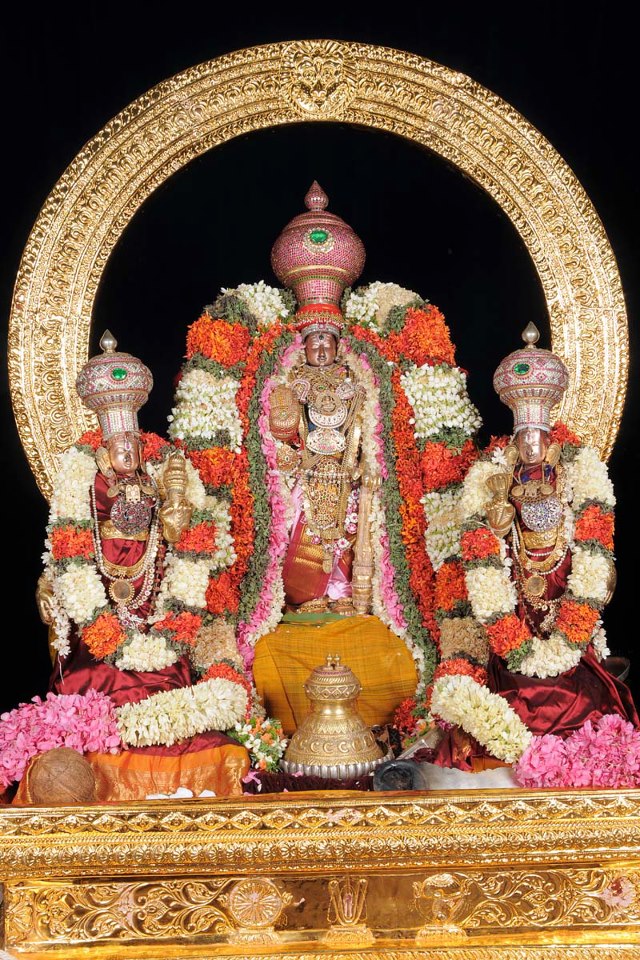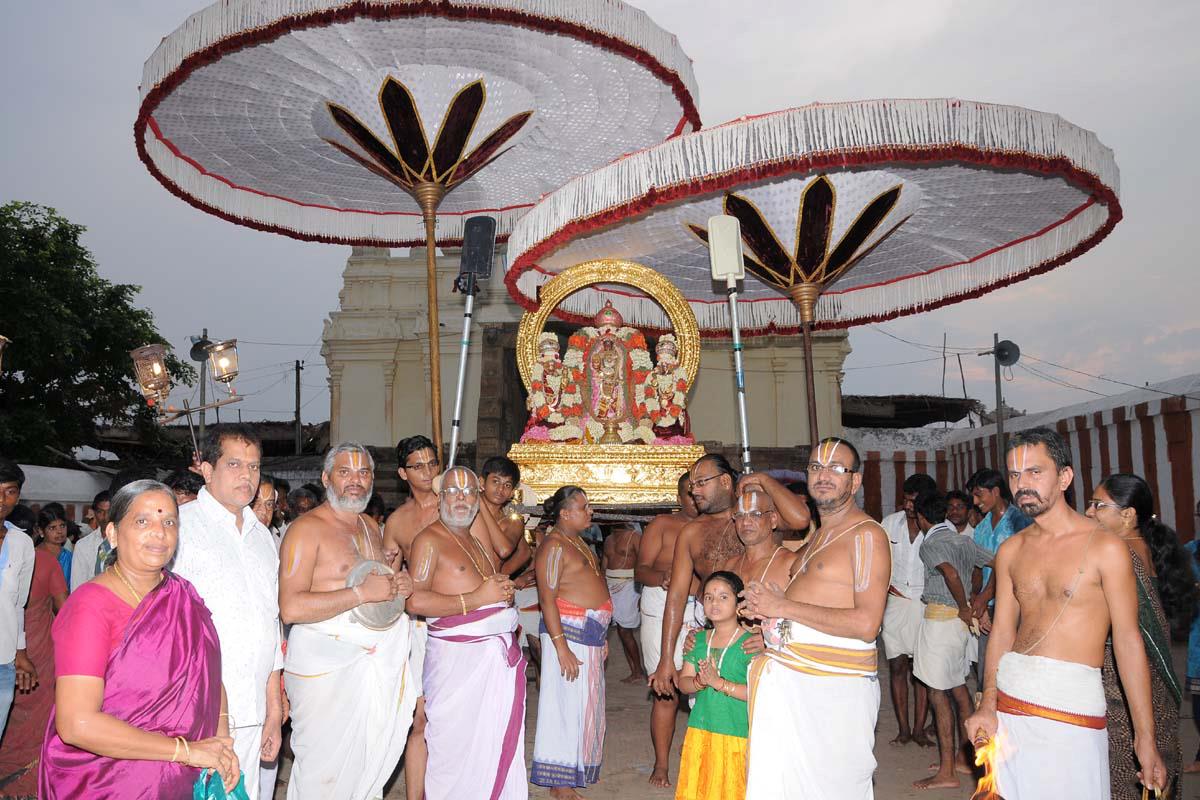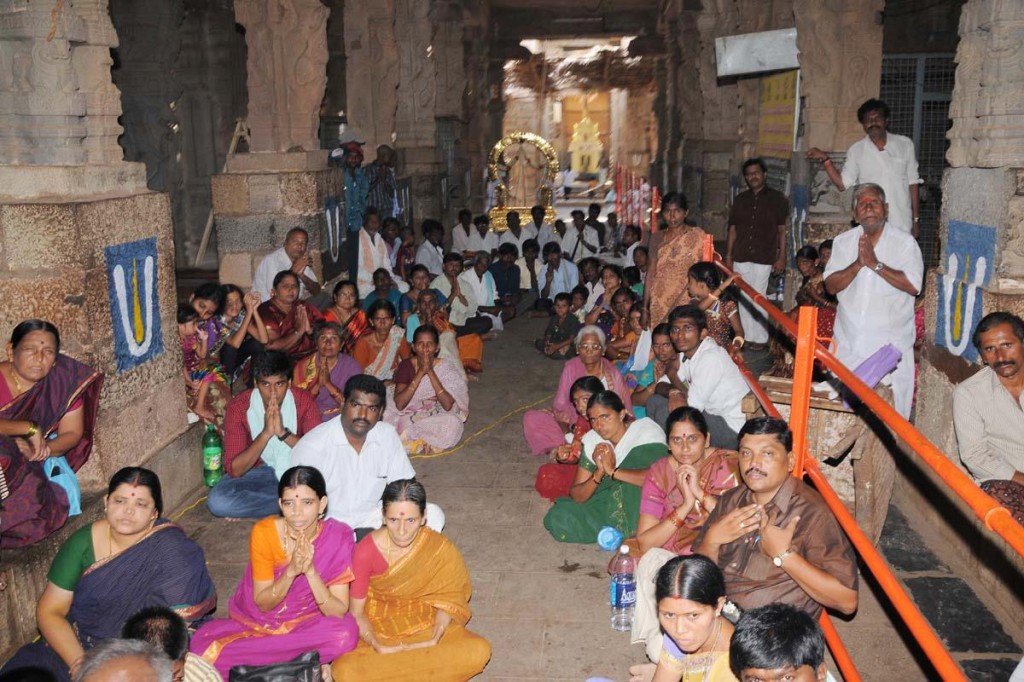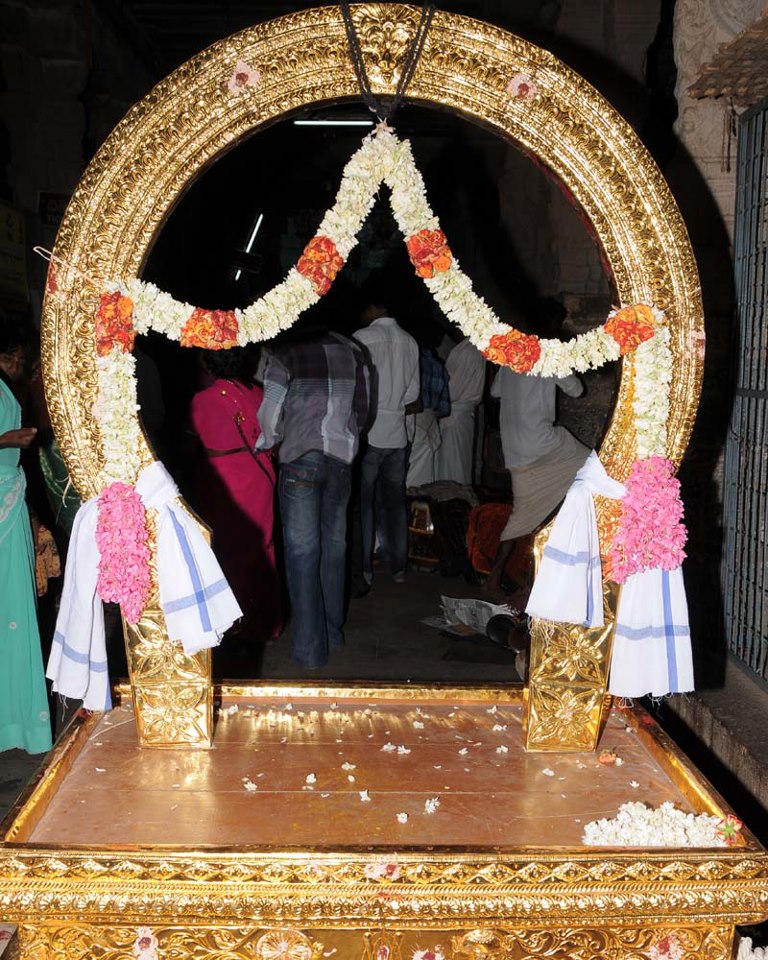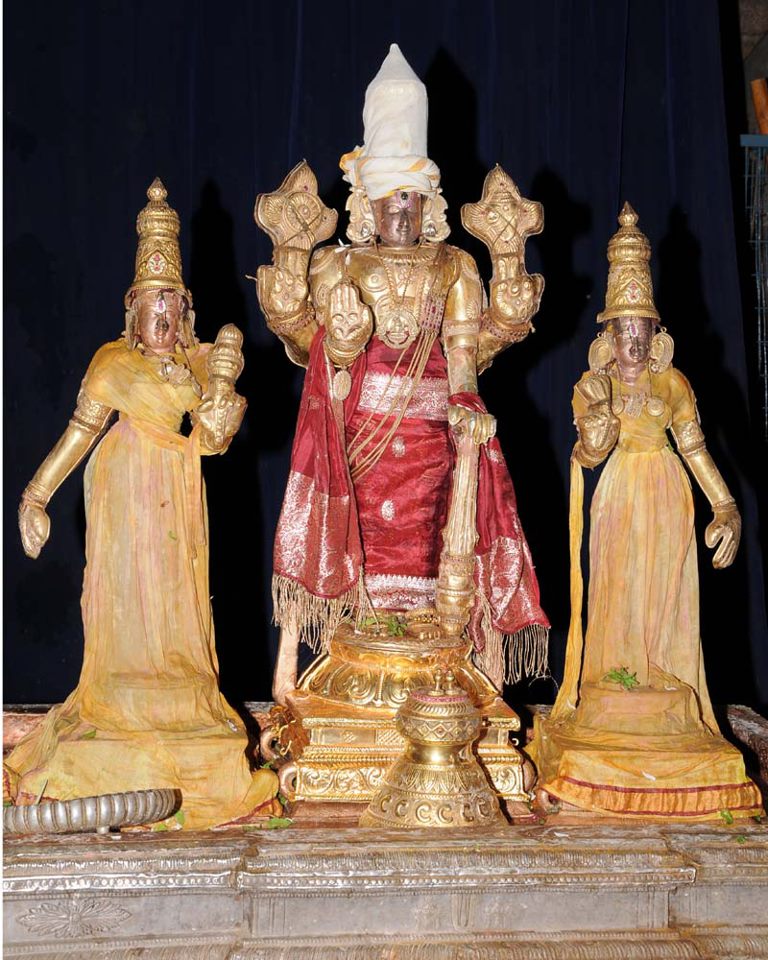Sri Prahladavaradan at Ahobilam gave devotees darshan on Mangalagiri Swarnapeetam, yesterday the 5th of May 2013. Prior to the purapaddu, Perumal had Thirumanjana Sevai. Hundreds of devotees attended the thirumanjanam and purappadu. Some of the photos and videos taken yesterday can be viewed below
Photos and videos: Thanks to Sri Prasad
Ahobilam is located in Karnool district of Andhra Pradesh in the hills of the eastern ghats, about 400 km northwest of Chennai.
The temple consists of nine shrines to Lord Nrisimha located around a 5 km circle. In addition to the nine shrines, there is a temple for Prahaladavarada Varadhan in the foothills of the mountain. Due to security reasons and the difficulty in performing daily worship, many of the utsava vigrahas of the nine shrines are kept in this temple.
Garuda wished for a vision of Lord Nrisimha in the form of the Avathara. To fulfill his wish, the Lord settled in the hills around Ahobilam in the midst of dense forests in nine different forms. For this reason this hill came to be known as Garudadri, Garudachalam, and Garudasailam.
Ahobilam is the place where the Lord killed Hiranyakasipu and saved Prahalada. Mahalakshmi took avathar as Senjulakshmi among the Senju, tribal hunters of the hills, and married the Lord.
Sri Ahobila Matam, one of the most important Sri Vaishnava religious institutions in India, was established by Sri Athivan Satakopan at the instructions of Lord Lakshmi Nrisimha of Ahobilam. In fact, the utsava moorthy of the Malola Nrisimha temple, one of the nine shrines of Ahobilam, is the presiding deity of Sri Ahobila Mutham. Sri Malolan accompanies Srimad Azhagiya Singar, the spiritual and titular head of Sri Ahobila Mutham, on his travels.
Thirumangai Azhvaar has sung ten verses about this temple in Periya Thirumozhi.
Details
Perumal (Lord): Ahobila Nrisimha – Sitting posture in Chakrasana facing East (Main temple)
Thayar (Consort): Lakhmi, Senjulakshmi
Other shrines: Jwala Nrisimha, Malola Nrisimha, Kroda Nrisimha, Karanja Nrisimha, Bhargava Nrisimha, Yaogananda Nrisimha, Kshatravata Nrisimha, Pavana Nrisimha
Pushkarani : BhavaNasini, Bhargava, Indra, Nrisimha,Gaja Theerthams
Vimanam: Guhai (Cave)
Pratyaksham: Prahalada, Adivan Satakopan
Sthala Puranam
The Himalayas rise high to the Everest in the north while the far south of India shows the deep sea – rather communion of the three oceans. The western region and the eastern region of the Peninsular India, on the other hand, while tapering towards Kanyakumari, exhibit a wide range of mountains known as Western Ghats present wholesome sceneries and adventurous travel both by rail and road, the Eastern Ghats display not only picturesque view but demonstrate divinity as well. The Eastern Ghats are likened to the great serpent Adhisesha basking in the sun with its head (or hood) at Thirumala, its middle at Ahobilam and its tail- end portion at Srisailam – all the three with famous temples on them.
The subject we have before us is Ahobilam. Of course, Thirupathi and Srisailam are also frequented pilgrimage centres. Ahobilam because of this special issue. Not only Mahabharatha; but also ancient puranas like Koorma Purana, Padma Purana and Vishnu Purana mention about Ahobilam and its presiding deity Narasimha. In fact, Brahmanda Purana says that this place was once the palace of Hiranyakasipu who was slain by Sriman Narayana manifesting as Narasimha from a pillar there for the sake of his staunch devotee Prahlada. Vagaries of time brought about the destruction of the then existing structures yielding place to nature’s creation of the mountain range that preserved the site of incarnation as “Svayam Vyakta Kshetram” of Lord Narasimha.
According to Stala Purana, there are two popular legends for the derivation of the word ‘Ahobilam’. It is stated that the Devas (Gods), while witnessing the terrific aspect (Ugra Kala), the lord took on in order to tear to pieces Hiranyakasipu sung in His praise as ‘Ahobala’ (Lo: the strength). Hence this place has come to be known as Ahobilam. In support of this, there is a prapatthi sloka about-Ahobilam that reads:-
“Aho Veeryam Aho Souryarn Aho Bahuparakramah
Naarasimham Param Daivam Ahobilam Aho Balam.
The other version is that because of the great cave, the Ahobila, where Garuda worshipped, did penance and realised the lord, the place itself has come to be called Ahobilam. The Ahobilam ‘Kaifiyat’ gives support to this legend. (The Ahobilam Kaifiyat forming part of Mackenzie collections gives very valuable information regarding the Ahobilam temples. Kaifiyats – the digests from ‘Kaviles’ or village registers containing information on the political, social, religious and other conditions of the villages in Deccan were prepared by Pandits and Mussadis working under Col. Mackenzie.) The Ahobilam Kaifiyat is in Telugu and available in the State Archives at Hyderabad (vide “Ahobila Narasimhaswamy temple” – Monograph by P. Sitapati, Commissioner of Archives).
As per this record, “On one of the mountains in the Nallamalai hills range, eight amadas from Srisaila Kshetra, Garuda commenced silent penance to obtain a vision of Lord Narasimha who destroyed Hiranyakasipu. The Lord in his grace, after long years of the tapas of Garuda, manifested Himself in the cave of a mountain”.
“Ten ‘Paruvus’ to the north-east of the mountain, where Garuda was doing penance, a vision of His manifestation was then granted to Garuda, who after obtaining a sign of the location of the mountain-cave, gladly traveled thither and saw the embodiment of the Sathsvaroopa,’ Mahapurusha, Lord Jwalanarasimha – not easily accessible to common people. Garuda then worshipped the Lord and praised him that ‘Ahobilam is Mahabalam’ (Ahobilam is a great sustainer with strength). The Lord’s Divya Mangala Vigraha was worshipped by him with several sthotras- Garuda then considered himself as blessed after a vision of the Lord. This divine place thereafter obtained the deserving name of Ahobilam”.
“The mountain on which Garuda performed tapas became famous as Garudachala. In the days of yore when truth and dharma prevailed, great heat was observable near the mountain- cave of Ahobila; according to legend when green grass was put in the cave, it would catch fire and smoke would be emitted. Several great Rishis lived there for a time; after sometime with the knowledge that great places would become common Janapadas in the Kali age, they left for northern lands, covering up the Narasimha cave with boulders. Traditionally therefore this place is being called the Narasimha Kshetra. There are thus nine Narasimha places, Nava-Narasimhas; Rishi- installed and worshipping areas:
Jwala Ahobila Malola Kroda Karanja Bhargava
Yogananda Kshatravata Pavana Nava Moorthayaha.
The Nine Narasimhasthalas are :- 1. Jwala Narasimha 2. Ahobila Narasimha 3. Malola Narasimha 4. Kroda Narasimha 5. Karanja Narasimha 6. Bhargava Narasimha 7. Yogananda Narasimha 8. Kshatravata Narasimha and 9. Pavana or holy
Narasimha.
Before visiting these nine shrines, let us see how we approach the place. Situated in the Nallamalai Hills, Ahobilam is about 24 Kms. from Allagadda Taluk Headquarters, 112 Kms. from Cudappah and 65 Kms. from Nandyal in Andhra Pradesh and can be reached by bus from Hyderabad and also by rail via Kurnool and then by bus from there. Long long ago, the Tamil mystic bard, Thirumangai Azhwar sang that Singavel Kunram (Ahobilam) was accessible to none but Gods.
Due to the efforts of the current 45th Srimad Azhagiyasingar, the access routes to several of the shrines have been greatly simplified such that people of different age groups are now able to visit the places easily. The whole complex is in two parts – one called Eguvu Ahobilam (Upper Ahobilam) with Nava Narasimha shrines and the other called Diguvu Ahobilam (Lower Ahobilam) with a single shrine for Lakshmee Narasimha connected by a road, stretching a distance of about 12.8 Kms. from Lower Ahobilam to Upper Ahobilam.
To read more about Sthala puranam and Travelogue, click here: http://anudinam.org/2011/12/10/ahobilam-nava-narasimha-sthalas/


